Papers by Patricia Resick
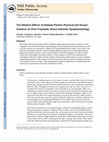
Violence and Victims, 2003
This study examined the relative effects of intimate partner physical and sexual violence on Post... more This study examined the relative effects of intimate partner physical and sexual violence on Post-Traumatic Stress Disorder (PTSD) symptomatology. Severity of physical and sexual violence as well as PTSD severity were assessed in a sample of 62 help-seeking battered women. The results of this study were consistent with prior research, finding significant and positive relationships between physical and sexual violence as well as sexual violence and PTSD symptoms. In order to further clarify these relationships, the unique effects of sexual violence on PTSD were examined after controlling for physical violence severity. Results indicated that sexual violence severity explained a significant proportion of the variance in PTSD severity beyond that which was already accounted for by physical violence severity. These findings have important implications for mental health and social service professionals who work with battered women.
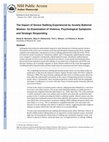
Violence and Victims
Stalking has been relatively understudied compared to other dimensions of intimate partner violen... more Stalking has been relatively understudied compared to other dimensions of intimate partner violence. The purpose of this article was to examine concurrent and subsequent intimate partner abuse, strategic responses and symptomatic consequences of severe stalking experienced by battered women. Thirty-five battered women classified as "relentlessly stalked" and 31 infrequently stalked battered women were compared. Compared to infrequently stalked battered women, relentlessly stalked battered women reported: (a) more severe concurrent physical violence, sexual assault and emotional abuse: (b) increased post-separation assault and stalking; (c) increased rates of depression and PTSD; and (d) more extensive use of strategic responses to abuse. Results underscore the scope and magnitude of stalking faced by battered women and have implications for assessment and intervention strategies.

Depression and Anxiety
This review examines the question of whether there should be a cluster of disorders, including th... more This review examines the question of whether there should be a cluster of disorders, including the adjustment disorders (ADs), acute stress disorder (ASD), posttraumatic stress disorder (PTSD), and the dissociative disorders (DDs), in a section devoted to abnormal responses to stress and trauma in the DSM-5. Environmental risk factors, including the individual's developmental experience, would thus become a major diagnostic consideration. The relationship of these disorders to one another is examined and also their relationship to other anxiety disorders to determine whether they are better grouped with anxiety disorders or a new specific grouping of trauma and stressor-related disorders. First how stress responses have been classified since DSM-III is reviewed. The major focus is on PTSD because it has received the most attention, regarding its proper placement among the psychiatric diagnoses. It is discussed whether PTSD should be considered an anxiety disorder, a stress-induc...

Depression and Anxiety
This is a review of the relevant empirical literature concerning the DSM-IV-TR diagnostic criteri... more This is a review of the relevant empirical literature concerning the DSM-IV-TR diagnostic criteria for PTSD. Most of this work has focused on Criteria A1 and A2, the two components of the A (Stressor) Criterion. With regard to A1, the review considers: (a) whether A1 is etiologically or temporally related to the PTSD symptoms; (b) whether it is possible to distinguish "traumatic" from "non-traumatic" stressors; and (c) whether A1 should be eliminated from DSM-5. Empirical literature regarding the utility of the A2 criterion indicates that there is little support for keeping the A2 criterion in DSM-5. The B (reexperiencing), C (avoidance/numbing) and D (hyperarousal) criteria are also reviewed. Confirmatory factor analyses suggest that the latent structure of PTSD appears to consist of four distinct symptom clusters rather than the three-cluster structure found in DSM-IV. It has also been shown that in addition to the fear-based symptoms emphasized in DSM-IV, trau...
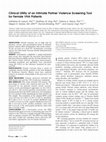
Journal of General Internal Medicine
Female Veterans are at high risk for physical, sexual, and psychological forms of intimate partne... more Female Veterans are at high risk for physical, sexual, and psychological forms of intimate partner violence (IPV) victimization. This study evaluated the accuracy of a brief IPV victimization screening tool for use with female Veterans Health Administration (VHA) patients. Participants completed a paper-and-pencil mail survey that included the four-item Hurt/Insult/Threaten/Scream (HITS) and the 39-item Revised Conflict Tactics Scales (CTS-2). Operating characteristics, including sensitivity and specificity, were calculated using the CTS-2 as the reference standard for past-year IPV. Female veterans from a roster of randomly selected female patients of the New England VA Healthcare System. Women must have reported being in an intimate relationship in the past year to be included. Primary measures included the HITS (index test) and the CTS-2 (reference standard). This study included 160 women. The percentage of women who reported past-year IPV, as measured by any physical assault, se...
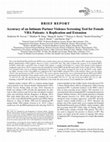
Journal of Traumatic Stress
The 4-item Hurt/Insult/Threaten/Scream (HITS) tool accurately detects past-year intimate partner ... more The 4-item Hurt/Insult/Threaten/Scream (HITS) tool accurately detects past-year intimate partner violence (IPV) among female Veterans Health Administration (VHA) patients; however, it lacks a sexual IPV item. This study evaluated the accuracy of an extended HITS (E-HITS), which adds a sexual IPV item, in female VHA patients. A sample of 80 female U.S. veteran VHA patients in New England completed a mail survey (50.0% response rate) that included the 5-item E-HITS and the Revised Conflict Tactics Scales (CTS-2). Women were included if they were in an intimate relationship in the past year. The women averaged 49 years of age and 86.0% of the sample was White. Accuracy of the 4-item HITS was compared to the 5-item E-HITS, using the CTS-2 as the reference. There were 20 women (25.0%) who reported past-year IPV on the CTS-2. The receiver operator characteristic curves demonstrated that the HITS and E-HITS performed nearly identically at their optimal cutoff scores of 6 and 7, respectivel...

Journal of Consulting and Clinical Psychology, 2015
To determine whether group therapy improves symptoms of posttraumatic stress disorder (PTSD), thi... more To determine whether group therapy improves symptoms of posttraumatic stress disorder (PTSD), this randomized clinical trial compared efficacy of group cognitive processing therapy (cognitive only version; CPT-C) with group present-centered therapy (PCT) for active duty military personnel. Patients attended 90-min groups twice weekly for 6 weeks at Fort Hood, Texas. Independent assessments were administered at baseline, weekly before sessions, and 2 weeks, 6 months, and 12 months posttreatment. A total of 108 service members (100 men, 8 women) were randomized. Inclusion criteria included PTSD following military deployment and medication stability. Exclusion criteria included suicidal/homicidal intent or other severe mental disorders requiring immediate treatment. Follow-up assessments were administered regardless of treatment completion. Primary outcome measures were the PTSD Checklist (Stressor Specific Version; PCL-S) and Beck Depression Inventory-II. The Posttraumatic Stress Symptom Interview (PSS-1) was a secondary measure. Both treatments resulted in large reductions in PTSD severity, but improvement was greater in CPT-C. CPT-C also reduced depression, with gains remaining during follow-up. In PCT, depression only improved between baseline and before Session 1. There were few adverse events associated with either treatment. Both CPT-C and PCT were tolerated well and reduced PTSD symptoms in group format, but only CPT-C improved depression. This study has public policy implications because of the number of active military needing PTSD treatment, and demonstrates that group format of treatment of PTSD results in significant improvement and is well tolerated. Group therapy may an important format in settings in which therapists are limited. (PsycINFO Database Record
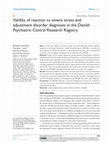
Clinical Epidemiology, 2015
To assess the validity of reaction to severe stress and adjustment disorder diagnoses registered ... more To assess the validity of reaction to severe stress and adjustment disorder diagnoses registered in the Danish Psychiatric Central Research Register (DPCRR), to examine the documentation of stressful and traumatic events in the medical records, and to investigate the occurrence of stress diagnoses among persons not registered in the DPCRR. Methods: Among 101,633 patients diagnosed with International Classification of Diseases, 10th Edition (ICD-10) F43 diagnoses between 1995 and 2011, we selected 50 patients from two hospitals (100 total), comprising one above and one below median age for each diagnosis for five time periods, and reviewed their medical records. We calculated the positive predictive value, comparing registration in the DPCRR with the original medical records, and captured data on stressful life events. Two general practitioners were queried about 50 patients without a stress diagnosis in the DPCRR, regarding whether they had ever received a stress diagnosis. Results: The positive predictive value was 58% for acute stress reaction, 83% for posttraumatic stress disorder, 94% for adjustment disorder, 71% for other reactions to severe stress, and 68% for reaction to severe stress, unspecified. In 80% of the records, a stressful or traumatic event was noted. Of 100 patients without an F43 diagnosis in the DPCRR, seven had a stress diagnosis. Conclusion: The DPCRR represents a valid and comprehensive resource for research on reaction to severe stress and adjustment disorders, particularly for posttraumatic stress disorder and adjustment disorder.
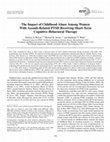
Journal of traumatic stress, 2014
This study examined the effect of child sexual or physical abuse on brief cognitive-behavioral th... more This study examined the effect of child sexual or physical abuse on brief cognitive-behavioral therapy treatments with adults with posttraumatic stress disorder (PTSD). We analyzed secondary data from two randomized controlled trials (Resick, Nishith, Weaver, Astin, & Feuer, 2002; Resick et al., 2008) that included women with PTSD who did or did not have child sexual abuse (CSA) or child physical abuse (CPA) histories to determine whether childhood abuse impacted dropout rate or reduction in PTSD symptoms. In Study 1, presence, duration, or severity of CSA was not associated with dropout; however, frequency of CSA significantly predicted dropout (OR = 1.23). A significant CPA Severity × Treatment Group interaction emerged such that CPA severity was associated with greater dropout for prolonged exposure (PE; OR = 1.45), but not cognitive processing therapy (CPT; OR = 0.90). Study 2 found no differences in dropout. Study 1, comparing CPT and PE among women who experienced at least 1 r...
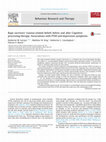
Behaviour research and therapy, 2015
This study examined whether cognitive distortions (i.e., assimilated and overaccommodated thought... more This study examined whether cognitive distortions (i.e., assimilated and overaccommodated thoughts) and realistic (i.e., accommodated) thoughts assessed from impact statements written 5-10 years after completing cognitive processing therapy (CPT) accurately predicted posttreatment maintenance or decline in treatment gains during the same period. The sample included 50 women diagnosed with posttraumatic stress disorder (PTSD) secondary to rape who participated in a randomized clinical trial of CPT for PTSD. Cognitions were assessed via coding and analyses of participants' written impact statements at three time points: beginning of treatment, end of treatment, and at 5-10 years follow-up. Primary mental health outcomes were symptoms of PTSD (Clinician-Administered PTSD Scale) and depression (Beck Depression Inventory). Changes in trauma-related beliefs between the end of treatment and long-term follow-up were associated with concomitant changes in PTSD and depression symptoms (ef...

Violence and victims, 2013
Intimate partner violence (IPV) survivors often report histories of childhood maltreatment, yet t... more Intimate partner violence (IPV) survivors often report histories of childhood maltreatment, yet the unique contributions of childhood maltreatment on IPV survivors' distinct posttraumatic stress disorder (PTSD) symptoms remain inadequately understood. Using interview and self-report measures, we examined IPV as a potential mediator of the association between childhood maltreatment and severity of PTSD symptom clusters (reexperiencing, avoidance, numbing, and hyperarousal) among a sample of 425 women seeking help for recent IPV. Structural equation modeling demonstrated that while both childhood maltreatment and IPV were both positively associated with PTSD symptom clusters, IPV did not mediate the association between childhood maltreatment and severity of PTSD symptom clusters among acute IPV survivors. Childhood maltreatment has persistent effects on the PTSD symptoms of IPV survivors, suggesting that child maltreatment may need to be addressed in addition to IPV during PTSD tr...
Cognitive and Behavioral Practice, 1997
With the advent of managed care, there is an increasing need for short-term, empirically based tr... more With the advent of managed care, there is an increasing need for short-term, empirically based treatments. This article presents a cognitive behavioral therapy protocol for the treatment of adult survivors of childhood sexual abuse, Cognitive Processing Therapy for Sexual Abuse (CPT-SA). Based on information processing, developmental and self-trauma theories, this 26-session model combines group and individual therapy over a 17-week period. Clients are asked to write about the trauma, and explore adaptive, schema congruent, and discrepant beliefs that developed during and after the abuse. Focus is placed on beliefs related to safety, trust, power/control, self-esteem, and intimacy, with individual modules for each of these areas. Initial pilot data (N = 15), clinical implications, and two client case studies are also discussed.

Journal of Traumatic Stress, 2014
This study conducted secondary analyses of a published trial and sought to determine if different... more This study conducted secondary analyses of a published trial and sought to determine if different domains of psychosocial functioning (e.g., daily living, work, nonfamily relationships) improved following trauma-focused treatment for posttraumatic stress disorder (PTSD). Cognitive processing therapy (CPT), an empirically supported treatment that involves evaluating trauma-related beliefs and written trauma accounts, was compared to its components: CPT without the written accounts or written accounts only in a sample of 78 women with PTSD secondary to interpersonal violence. Overall and individual domains of functioning significantly improved with treatment and results were similar across treatment groups, Fs (2, 150) ≥ 11.87, ps < .001. Additionally, we investigated whether changes in different PTSD symptom clusters were associated with outcomes in domains of psychosocial functioning, after collapsing across treatment condition. Multiple hierarchical linear regression analyses revealed that overall clinician-assessed PTSD symptom reduction was associated with outcomes in all domains of functioning, βs = .44 to .68, ps < .001. Additionally, improvements in the emotional numbing symptom cluster were associated with outcomes in the nonfamily relationships domain, β = .42, p < .001, and improvements in the hyperarousal symptom cluster were associated with outcomes in the overall, daily living, and household tasks domains, βs = .34 to .39, ps < .01. Results suggest that it may be important to monitor improvements in emotional numbing and hyperarousal symptoms throughout treatment to increase the likelihood of changes in psychosocial functioning.
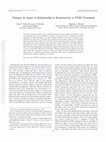
Psychological trauma : theory, research, practice and policy, 2014
This study examined the clinical course of different dimensions of anger and their relationship t... more This study examined the clinical course of different dimensions of anger and their relationship to change in posttraumatic stress disorder (PTSD) in a sample of 139 female survivors of interpersonal violence suffering from PTSD. Specifically, this study evaluated differences in the rates of change in anger dimensions by responsivity to treatment status (responders, non-responders, and drop-outs). Responders and non-responders did not differ in rate of change on state anger and anger directed inward, suggesting that treatment led to improvements in these dimensions of anger regardless of final PTSD diagnosis. Responders did evidence statistically significantly more change in trait anger and control over one's anger than did the non-responders, suggesting that changes in these dimensions of anger may be related to recovery from PTSD. Individuals who terminated therapy prematurely did not experience the same gains in state anger, trait anger, or anger-in as those who completed trea...
Addictive Behaviors, 2007
Alcohol use is frequently associated with posttraumatic stress disorder (PTSD), especially in the... more Alcohol use is frequently associated with posttraumatic stress disorder (PTSD), especially in the face of chronic traumatic experiences. However, the relationship between alcohol use and symptoms associated with chronic trauma exposure has not been evaluated. This study examined alcohol use in recently battered women (N=369). Differences were found in trauma symptoms between abstainers, moderate drinkers, and heavy drinkers, with heavy
Journal of Traumatic Stress, 2003
Few studies have examined the impact of trauma research participation upon trauma survivors. Empi... more Few studies have examined the impact of trauma research participation upon trauma survivors. Empirical data regarding reactions to research participation would be very useful to address the question of whether it is harmful for trauma survivors to participate in trauma studies. We examined participant reactions to different trauma assessment procedures in domestic violence (N = 260), rape (N = 108),
Journal of Consulting and Clinical Psychology, 2002
The purpose of this study was to compare cognitive-processing therapy (CPT) with prolonged exposu... more The purpose of this study was to compare cognitive-processing therapy (CPT) with prolonged exposure and a minimal attention condition (MA) for the treatment of posttraumatic stress disorder (PTSD) and depression. One hundred seventy-one female rape victims were randomized into 1 of the 3 conditions, and 121 completed treatment. Participants were assessed with the Clinician-Administered PTSD Scale, the PTSD Symptom Scale, the Structured Clinical Interview for DSM-IV, the Beck Depression Inventory, and the Trauma-Related Guilt Inventory. Independent assessments were made at pretreatment, posttreatment, and 3 and 9 months posttreatment. Analyses indicated that both treatments were highly efficacious and superior to MA. The 2 therapies had similar results except that CPT produced better scores on 2 of 4 guilt subscales.

Uploads
Papers by Patricia Resick